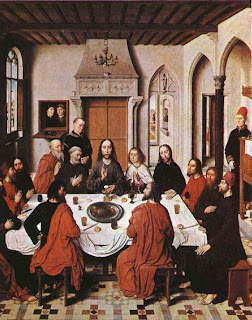Well! I have a few of you that have been asking me if I have some books on the napkins technique. I would love to offer some books on the napkins technique, but I am not able to find great ones in English. There are galore of books in French, but so few in English. I intend to add a French version of the site for my French-speaking customers. So I will offer the books in French. In the meantime, while trying to locate great books in English, I'll post more steps by steps projects or pictures with this technique.
Nowadays we have a great deal of choice with the paper napkins. They are great embellishments for our interiors. They allow us to be different by customizing our furniture, even our gifts. But how was it before the paper napkins. Who is the ancestor? Where did all start? Well my friends, here's a little historical recap. I hope you'll enjoy it as much as I did.
Napkins sizes and uses have changed over the years. The museums are great places with their paintings to illustrate that. From the large linen cloth to the small squared absorbent paper, the napkin has changed during the courses of centuries, but its function is still the same: cleanliness and protection of clothing.
In the XVth century, the collective napkin appears in a painting by the Flemish painter Dirk Bouts: 
The Last Supper, Dirk Bouts (1415-1475), collegiate Saint Pierre de Louvain
We can see the napkin was a collective one for two, three guests. The napkin at this time was a very long linen cloth which ran along the table. There were no forks, they ate with their hands. The napkin wasn't superfluous!
During the Renaissance, the knives and forks appeared. They don't wipe anymore on the back of the hand or on the sleeve. The napkin became individual. The good manners code pointed out that ones needed to wipe his mouth and fingers before drinking. In other words, there was no more possibilities to transform ones glass into a trough with pigs!
We can see this first white napkin around the neck of a guest in the painting of Veronese "Wedding of Cana".
This is one of the biggest painting in the Louvre museum in Paris. Time to buy your ticket ;-)
In XVIIth century, the napkin spreaded on tables, at least in the bourgeois houses, and becomes a smart element of decor in the Dutch pictures for instance:
Willem Kalf, Desert, Ermitage Saint Pétersbourg
Jan Vermeer, Lady and gentlemen, museum of Brunswick
From now on, the napkin is seen in during the feasts...

Jan Steen, "The Twelfth-night", museum of Kassel
During the XVIIIth century, the napkin keeps its big dimensions, at least a metre aside, is in linen embroidered, monogrammed, damasked cotton. It hangs onto the buttonhole of the men' jacket:

Nicolas Lancret, " The lunch of ham ", Condé de Chantilly museum.
Jean-François de Troy often represented meals, where the napkin is staged in a nice way:

J.F. of Troy, "The lunch of oysters" Condé of Chantilly museum.

Claude Monet, Stadel museum Franckfort
In this beautiful painting of Monet we can see the ring napkin which still exist under this form.



0 commentaires:
Post a Comment